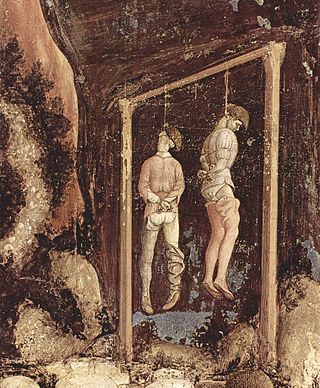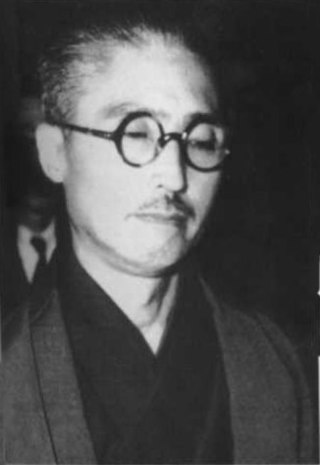Related Research Articles

Hanging is killing a person by suspending them from the neck with a noose or ligature. Hanging has been a common method of capital punishment since the Middle Ages, and is the primary execution method in numerous countries and regions. The first known account of execution by hanging is in Homer's Odyssey. Hanging is also a method of suicide.
Capital punishment in Canada dates back to Canada's earliest history, including its period as a French colony and, after 1763, its time as a British colony. From 1867 to the elimination of the death penalty for murder on July 26, 1976, 1,481 people had been sentenced to death, and 710 had been executed. Of those executed, 697 were men and 13 women. The only method used in Canada for capital punishment of civilians after the end of the French regime was hanging. The last execution in Canada was the double hanging of Arthur Lucas and Ronald Turpin on December 11, 1962, at Toronto's Don Jail. The National Defence Act prescribed the death penalty for certain military offences until 1999, although no military executions had been carried out since 1946.
Dhananjoy Chatterjee was the first person who was judicially executed in India in the 21st century for murder. The execution by hanging took place in Alipore Jail, Kolkata, on 15 August 2004. He was charged in 1990 for the crimes of rape and murder of Hetal Parekh, an 18-year-old school-girl.

Sadamichi Hirasawa was a Japanese tempera painter. He was convicted of mass poisoning and sentenced to death. Due to strong suspicions that he was innocent, no justice minister ever signed his death warrant.
Capital punishment was abolished in 2019 in New Hampshire for persons convicted of capital murder. It remains a legal penalty for crimes committed prior to May 30, 2019.
The Caledon Bay crisis refers to a series of killings at Caledon Bay in the Northern Territory of Australia during 1932–34, referred to in the press of the day as Caledon Bay murder(s). Five Japanese trepang fishers were killed by Aboriginal Australians of the Yolngu people. A police officer investigating the deaths, Albert McColl, was subsequently killed. Shortly afterwards, two white men went missing on Woodah Island (with one body found later). With some of the white community alarmed by these events, a punitive expedition was proposed by Northern Territory Police to "teach the blacks a lesson".
Capital punishment is a legal penalty in Sri Lanka.
Wrongful execution is a miscarriage of justice occurring when an innocent person is put to death by capital punishment. Cases of wrongful execution are cited as an argument by opponents of capital punishment, while proponents say that the argument of innocence concerns the credibility of the justice system as a whole and does not solely undermine the use of the death penalty.

Capital punishment is a legal penalty in Japan. In practice, it is applied only for aggravated murder, but the current Penal Code and several laws list 14 capital crimes, including conspiracy to commit civil war; conspiracy with a foreign power to provoke war against Japan; murder; obstruction of the operation of railroads, ships, or airplanes resulting in the death of the victim; poisoning of the water supply resulting in the death of the victim; intentional flooding; use of a bomb; and arson of a dwelling; all resulting in the death of the victim. Executions are carried out by long drop hanging, and take place at one of the seven execution chambers located in major cities across the country.
Iwao Hakamada is a Japanese former professional boxer who was sentenced to death on September 11, 1968, for a 1966 mass murder that became known as the Hakamada Incident. On March 10, 2011, Guinness World Records certified Hakamada as the world's longest-held death row inmate. In March 2014, he was granted a retrial and an immediate release when the Shizuoka district court found there was reason to believe evidence against him had been falsified.

Mahmood Hussein Mattan was a Somali former merchant seaman who was wrongfully convicted, in the United Kingdom, of the murder of Lily Volpert on 6 March 1952. The murder took place in the Docklands area of Cardiff, Wales, and Mattan was mainly convicted on the evidence of a single prosecution witness. Mattan was executed in 1952.
Leprosy stigma is a type of social stigma, a strong negative feeling towards a person with leprosy relating to their moral status in society. It is also referred to as leprosy-related stigma, leprostigma, and stigma of leprosy. Since ancient times, leprosy instilled the practice of fear and avoidance in many societies because of the associated physical disfigurement and lack of understanding behind its cause. Because of the historical trauma the word "leprosy" invokes, the disease is now referred to as Hansen's disease, named after Gerhard Armauer Hansen who discovered Mycobacterium leprae, the bacterial agent that causes Hansen's disease. Those who have suffered from Hansen's disease describe the impact of social stigma as far worse than the physical manifestations despite it being only mildly contagious and pharmacologically curable. This sentiment is echoed by Weis and Ramakrishna, who noted that "the impact of the meaning of the disease may be a greater source of suffering than symptoms of the disease".
Kikuchi Keifuen Sanatorium or National Sanatorium Kikuchi Keifuen is a sanatorium for leprosy patients or ex-leprosy patients at Kohshi-shi, Kumamoto-ken, Japan founded in 1909. The mean age of residents (ex-patients) is about eighty.

Karl Rudolf Werner Braune was a German SS functionary during the Nazi era and a Holocaust perpetrator. During the German invasion of the Soviet Union of 1941, Braune was the commander of Einsatzkommando 11b, part of Einsatzgruppe D. Braune organized and conducted mass murders of Jews in the Army Group South Rear Area, the Reichskommissariat Ukraine. For his role in these crimes, Braune was tried before an American military court in 1948 in the Einsatzgruppen trial. He was convicted, sentenced to death and executed in 1951.
The murder of Thomas Bates occurred during an armed robbery in Birmingham, England, on 2 June 1962. Oswald Grey was convicted of the crime, and became the last person hanged at the city's Winson Green Prison. Grey maintained his innocence and doubt remains as to whether or not there was sufficient evidence against him.
The Muraiken Undō, or No Leprosy Patients in Our Prefecture Movement, was a government funded Japanese public health and social movement which began between 1929 and 1934. Its mission was to systematically eliminate leprosy,, a readily transmissible, previously incurable, chronic infectious disease caused by M. leprae, from each prefecture in Japan. This was to be achieved by caring for those affected by the disease in government funded sanatoriums.
Sokichi Furutani was a Japanese serial killer, who in the span between October 30 and December 12, 1965, murdered eight elderly men in a robbery-murder spree. He is also suspected of being responsible for murders of four other men, two of them occurring in 1951.
Tetsuyuki Morikawa was a Japanese serial killer who killed two of his ex-wife's relatives in Kumamoto, after having been released on parole for killing his mother-in-law in 1962. For the latter crimes, Morikawa was sentenced to death and subsequently executed in 1999.
References
- ↑ 藤本事件 (in Japanese). Archived from the original on 2008-12-20. Retrieved 2008-06-08.
- ↑ Verification Committee Concerning Hansen's Disease Problem: Final Report